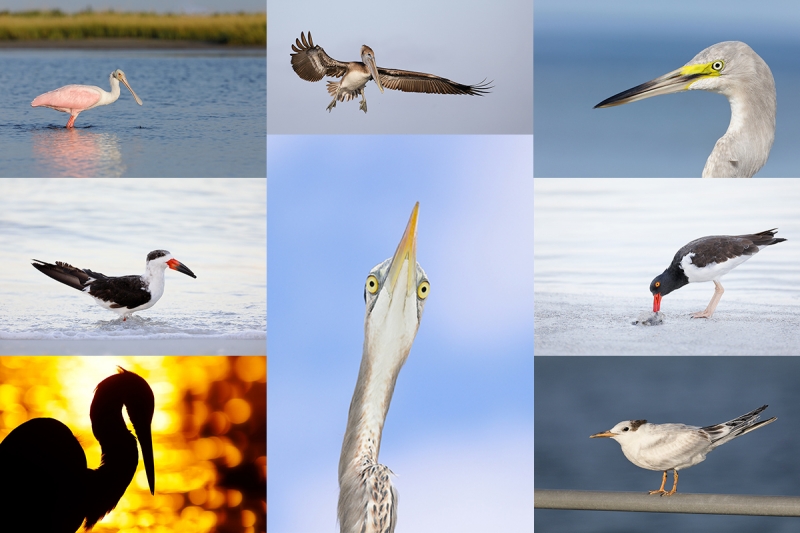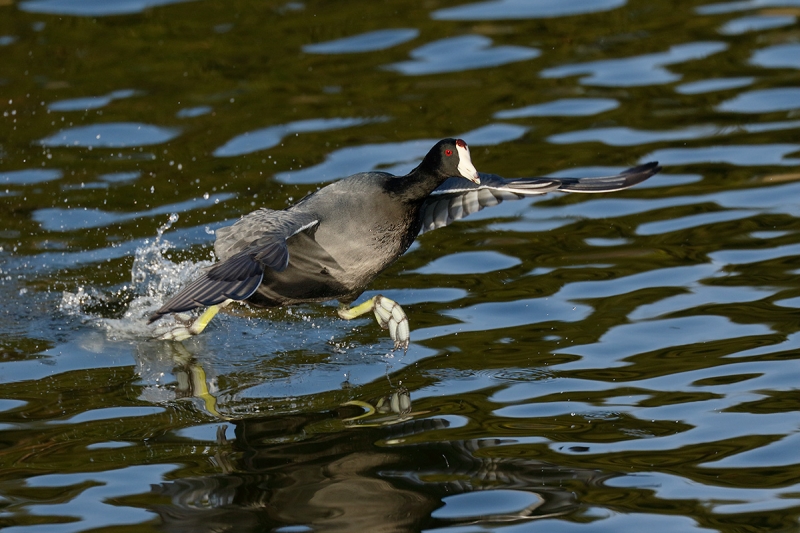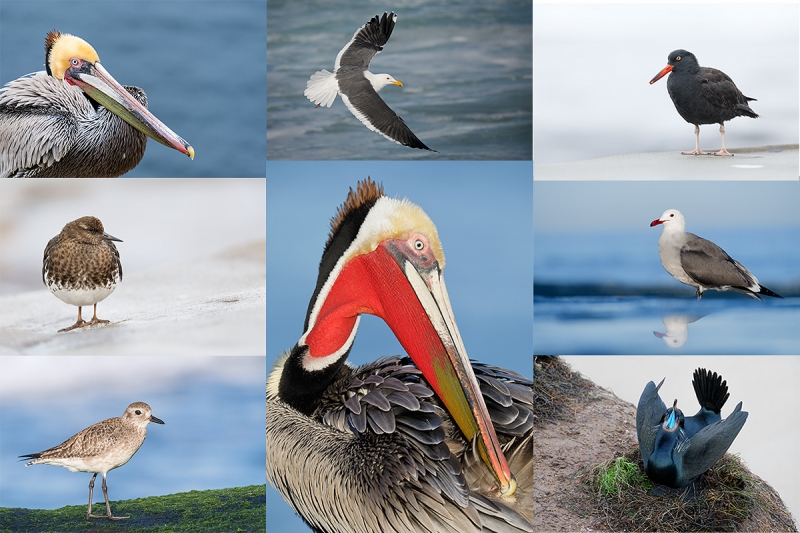Stuff
I got lots of work done early on Thursday and then got back to work on the 5D IV User’s Guide; it is tough sledding … Swam early — 60 lengths, about .68 mile, and then off to TJ the chiropractor. Late afternoon exercise and then a 20-image phone critique at 4:30pm. Who’s on Thursday Night Football?
I was glad to learn on Thursday of the sale of Mansoor Assadi’s used Canon EOS 5D Mark III digital camera body in excellent condition for $1225.
Due to a cancellation there is a single opening on San Diego IPT #1 (click here for details). And with only two folks signed up, there is lots of room on San Diego IPT #2 (scroll down here for details that one). I am offering a free Saturday morning session for those who sign up for San Diego #2.
|
|
Recent Fort DeSoto ImagesFrom bottom left clockwise back to center: Great Egret, blasting sunrise highlights; Black Skimmer, winter plumage in pre-dawn light; Roseate Spoonbill foraging; Brown Pelican, juvenile landing; hybrid heron X egret; American Oystercatcher feeding; Royal Tern, worn juvenile; Great Blue Heron from below. |
More Cheap Weekend Fort DeSoto In-the-Field Instruction
Sign up for the full day Saturday 11 NOV and the Friday afternoon session (4:30pm till sunset) on 10 NOV is free!
Saturday, November 11, 2017: Morning session — 6:45am for 3 1/2 hours: $149. Add lunch, image review, and Photoshop session: $249 (total).
Saturday, November 11, 2017: Afternoon session — 4:30pm for 3 hours: $99.
Saturday, November 11, 2017, both sessions including lunch: $329. Sign up for the full day Saturday and enjoy a Friday afternoon session for free.
Sunday, November 12, 2017: Morning session — 6:45am for 3 1/2 hours: $149.
Learn to get the right exposure every time, to approach free and wild (and often tame!) birds, and to design a pleasing image. And learn the location of my new Fort DeSoto hotspot along with my favorite sunset location (sky conditions permitting). To register call Jim or Jen at the office at 863-692-0906 or shoot me an e-mail.
Canon lens rentals are available on a limited basis: 600 II, 500 II, 400 DO II, and 200-400 f/4 with Internal TC.
Cheap but great instruction.
The Streak
Today makes ninety-nine days in a row with a new educational blog post! This one took less than an hour to prepare. With all of my upcoming free time (or not …), the plan right now is to break the current record streak of 480 … Good health and good internet connections willing.
Booking.Com
Booking.Com came through for me twice again recently with both the DeSoto Fall IPT and next July’s UK Puffins, Gannets, and Bempton Pre-trip room reservations. And all the rates were great. If you’d like to give Booking.Com a shot, click here and you will earn a $25 reward. Thanks to the many who have already tried and used this great service.


Gear Questions and Advice
Too many folks attending BAA IPTs and dozens of folks whom I see in the field, and on BPN, are–out of ignorance–using the wrong gear especially when it comes to tripods and more especially, tripod heads… Please know that I am always glad to answer your gear questions via e-mail.
|
|
|
This image was created on the 2016 San Diego IPT with the hand held Canon EF 100-400mm f/4.5-5.6L IS II USM lens and the greatest-ever value in a digital camera body, the 1.6X crop factor Canon EOS 7D Mark II. ISO 800: 1/2500 sec. at f/5.6 in Manual mode. AWB in soft, late afternoon light at 3:59pm. Center AF point/AI Servo/Expand AF was active at the moment of exposure. The selected AF point fell on the bird’s lower breast above the raised left foot; this was pretty much on the same plane as the coot’s eye. American Coot running |
Multiple Choice Exposure Quiz
Given the lighting conditions as noted in the caption above, which would be the correct EC (exposure compensation) for this image?
A: +1 1/3 stops
B: zero (the metered exposure)
C: -1 1/3 stops
Be sure to share your reasoning with us.
Waterfowl Opportunities in San Diego
We usually spend an afternoon or two (and sometimes a morning if we can pull ourselves away from the breeding plumage pelicans with their fire-engine red and rich olive bill pouches) at San Diego’s premier duck photography location. There we get to photograph Wood Duck, Ring-necked Duck, American Wigeon, Ruddy Duck, and the ubiquitous Mallard. Wood Ducks had been super-easy for many years but in 2016 and 2017 their numbers were reduced. Early 2017 reports on this species are encouraging. Both the drake and hen Ring-necked Ducks continue to be cooperative in good numbers. Feeding the waterfowl at this location is not only permitted but encouraged; the camp store sells scratch at a buck a bag. Whenever you are photographing ducks, do not forget to try for the common (and reputedly ugly) species.
Canon EOS 7D Mark II
Mike Lawie is offering a Canon EOS 7D Mark II body in near-mint condition for the BAA record-low price of $923. The sale includes the front cap,the strap, the original product box, and insured ground shipping via major courier to US addresses only. Your item will not ship until your check clears unless other arrangements are made.
Please contact Mike via e-mail or by phone at 1-231-206-3412 (Eastern time).
Both Patrick Sparkman and I used and loved the 7D Mark II until about two years ago when we both committed to using full frame Canon bodies. We both made some truly great images with it. Two of my three 2016 Nature’s Best honored entries were created with the 7D II, one still, and one video. One thing is for sure: the 7D Mark II is the greatest value ever in a digital camera body. artie
|
|
2017 in San Diego was a very good year …. |
2018 San Diego 3 1/2-DAY BIRDS AS ART IPT #2: Sunday, JAN 28 thru and including the morning session on Wednesday, JAN 31, 2018 and a free Saturday morning session the day before the IPT starts: 3 1/2 days (+1/2!): $1699. Limit: 8: Openings: 7.
Meet and Greet at 6:30pm on the evening before the IPT begins; Saturday, Jan 27, 2018.
San Diego IPT #2: Shorter and Less Expensive!
Please remember: I go with one.
Join me in San Diego near the end of January to photograph the spectacular breeding plumage Brown Pelicans with their fire-engine red and olive green bill pouches; Brandt’s (usually nesting and displaying) and Double-crested Cormorants; breeding plumage Ring-necked Duck; other duck species possible including Lesser Scaup, Redhead, Wood Duck and Surf Scoter; a variety of gulls including Western, California, and the gorgeous Heerman’s, all in full breeding plumage; shorebirds including Marbled Godwit, Whimbrel, Willet, Sanderling and Black-bellied Plover; many others possible including Least, Western, and Spotted Sandpiper, Black and Ruddy Turnstone, Semipalmated Plover, and Surfbird; Harbor Seal (depending on the current regulations) and California Sea Lion; and Bird of Paradise flowers. And as you can see by studying the two IPT cards there are some nice bird-scape and landscape opportunities as well. Please note: formerly dependable, both Wood Duck and Marbled Godwit have been declining at their usual locations for the past two years …
|
San Diego offers a wealth of very attractive natural history subjects. With annual visits spanning more than three decades I have lot of experience there…. |
With gorgeous subjects just sitting there waiting to have their pictures taken, photographing the pelicans on the cliffs is about as easy as nature photography gets. With the winds from the east almost every morning there is usually some excellent flight photography. And the pelicans are almost always doing something interesting: preening, scratching, bill pouch cleaning, or squabbling. And then there are those crazy head throws that are thought to be a form of intra-flock communication. You can do most of your photography with an 80- or 100-400 lens …
Did I mention that there are wealth of great birds and natural history subjects in San Diego in winter?
|
Though the pelicans will be the stars of the show on this IPT there will be many other handsome and captivating subjects in wonderful settings. |
The San Diego Details
This IPT will include four 3 1/2 hour morning photo sessions, three 2 1/2 hour afternoon photo sessions, three lunches, and after-lunch image review and Photoshop sessions. To ensure early starts, breakfasts will be your responsibility. Dinners are on your own so that we can get some sleep.
A $599 non-refundable deposit is required to hold your slot for this IPT. You can send a check (made out to “Arthur Morris) to us at BIRDS AS ART, PO Box 7245, Indian Lake Estates, FL, 33855. Or call Jim or Jennifer at the office with a credit card at 863-692-0906. Your balance, payable only by check, will be due on 11/1/2016. If we do not receive your check for the balance on or before the due date we will try to fill your spot from the waiting list. Please print, complete, and sign the form that is linked to here and shoot it to us along with your deposit check. If you register by phone, please print, complete and sign the form as noted above and either mail it to us or e-mail the scan. If you have any questions, please feel free to contact me via e-mail.
If In Doubt …
If in doubt about using the BAA B&H affiliate link correctly, you can always start your search by clicking here. Please note that the tracking is invisible. Web orders only. Please, however, remember to shoot me your receipt via e-mail.




Please Remember to use my Affiliate Links and to Visit the New BAA Online Store 🙂
To show your appreciation for my continuing efforts here, we ask, as always, that you get in the habit of using my B&H affiliate links on the right side of the blog for all of your photo and electronics purchases. Please check the availability of all photographic accessories in the New BIRDS AS ART Online Store, especially the Mongoose M3.6 tripod head, Wimberley lens plates, Delkin flash cards and accessories, and LensCoat stuff.
As always, we sell only what I have used, have tested, and can depend on. We will not sell you junk. We know what you need to make creating great images easy and fun. And please remember that I am always glad to answer your gear questions via e-mail.
I would of course appreciate your using our B&H affiliate links for all of your major gear, video, and electronic purchases. For the photographic stuff mentioned in the paragraph above, and for everything else in the new store, we, meaning BAA, would of course greatly appreciate your business. Here is a huge thank you to the many who have been using our links on a regular basis and those who will be visiting the New BIRDS AS ART Online Store as well.
Amazon.com
Those who prefer to support BAA by shopping with Amazon may use the logo link above.
Amazon Canada
Many kind folks from north of the border, eh, have e-mailed stating that they would love to help us out by using one of our affiliate links but that living in Canada and doing so presents numerous problems. Now, they can help us out by using our Amazon Canada affiliate link by starting their searches by clicking here.
Be sure to like and follow BAA on Facebook by clicking on the logo link upper right. Tanks a stack.
Typos
In all blog posts and Bulletins, feel free to e-mail or to leave a comment regarding any typos or errors. Just be right :).



















Hi Artie. The image is overall dark tones so the camera is likely to meter to bring the exposure up. This necessitates a compensation of -1 1/3. Don’t want to blow out those white highlights now.
To me, the most important element from an exposure standpoint are the highlights on the head. On my phone, it looks like the camera at 0EV nailed it.
Hi Artie, I would think that the exposure compensation would be -1 1/3 because overall the image seems to be predominately dark tones and the cameras meter would try to render these as 18% grey (neutral). Thanks for the ongoing teaching,
Jake
Agree with Jean-Louis et al. The water and bird’s dark body predominate the scene and thus the meter would tend to overexpose to render the 18% average exposure. Thus you probably dialed in – 1 1/3 stops to compensate and preserve the whites in the bill and face.
Hi Artie,
I have tried for this shot on numerous occasions when nothing else is working. You did a great job here. I always find I need to reduce the exposure to keep the bill in check. Coots have very bright bills. IF you desire to keep the bill in check, you need to go minus.
Catching these guys during a chase again is really tough and again, you did a great job with this one.
On the side, I also made the decision to move to full frame bodies, selling my 7DII last year. I know why I made that decision. I am curious why both you and Patrick made that move as well.
Thanks Frank, To answer your question, image quality and cropability (if that’s a word) 🙂
with love, artie
Artie: My experience tells me that “full frame” does indeed give better image quality than a crop sensor. But I’m not getting the “cropability” part (it is a word now! 🙂 ), which depends on pixel density (among other things). Can you expain further?
With high image quality you can be free to be aggressive with 5D Mark IV files.
with love, artie
Did you set the meter to +1 1/3 in manual on the light sky? And while keeping that setting the meter went to 0 when you framed the coot? The water and coot look about 0 to me and 0 would probably keep some detail in the white bill. Or am I way off?
Metering as framed.
a
Artie,
My answer (I haven’t quite learned this lesson yet) is to agree with the first poster. C):I would assume that with all of the dark water and dark bird, the meter is going to want to overexpose. I am thinking that a -1 1/3 stop adjustment would correctly expose the beak, feet, and breast area.
On the exposure question,
I would assume an exposure of – 1 1/3 stops
The meter is being influenced by the greater area which is darker “the water”
If the bird were in flight it would be the opposite we would compensate by + 1 1/3
Further, you have thought us to work in manual mode, when a subject is in constant light
Adjust what you feel is the initial exposure by metering on the clear blue sky, in this case soft late afternoon light. Start at +1 1/3 after a test shot check the histogram to fine tune.
Remenber to ETTR without clipping the whites.
The advantage with manual mode in constant light is that no matter the back ground
the light meter will compesate correctly.
Hope I learned my lesson correctly
Thank you for the great blog
Jean-Louis,
Thanks for your kind words. Note that I was in Manual mode …
with love, artie